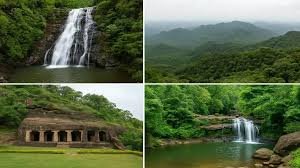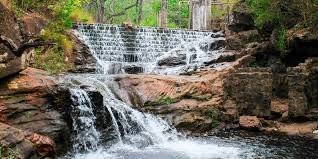Pachmarhi, Madhya Pradesh, is a unique hill station famed for its blend of awe-inspiring natural beauty, deep historical roots, vibrant local culture, and status as a prime tourist destination in Central India.
Pachmarhi is the only hill station in Madhya Pradesh, nestled in the Satpura Range at an altitude of around 1,067 meters, offering panoramic vistas, serene forests, and pleasant weather year-round. Its location, in the Hoshangabad district, makes it especially attractive for those seeking tranquility and a retreat from urban chaos.
Key Details:
Historical Background
The history of Pachmarhi is rich, stretching from mythological legends to British colonial times. According to legend, the Pandavas from the Mahabharata stayed in the region’s five caves (Pachmarhi literally means “five caves”) during their exile, a claim evidenced by ancient cave shelters and prehistoric paintings, some dating back over 10,000 years. In the modern era, Captain James Forsyth of the British Army rediscovered the site in 1857, transforming it into a British cantonment and summer resort due to its temperate climate and enchanting landscapes.
Culture and Festivals
Pachmarhi’s culture is a tapestry of tribal traditions, vibrant festivals, and folk art. Major celebrations include the Pachmarhi Utsav, a six-day annual festival full of performances, music, dance, and local crafts, typically held from December 25 through the New Year. Other key festivals include Holi, Diwali, Navratri, and New Year’s Eve, each celebrated with considerable local fervor. The region is also known for its folk music, dances like Matki, Raai, and Ahirai, and a rich culinary scene featuring Madhya Pradesh staples such as Daal Bafla and Bhutte ka Kees.
Tourist Attractions
Pachmarhi offers a wealth of natural and historical attractions:
- Pandava Caves: Ancient caves believed to shelter the Pandavas, now a protected monument and one of the most iconic sites.
- Bee Falls: Famous for its refreshing cascades and scenic beauty; a popular picnic spot.
- Dhoopgarh: The highest point in Madhya Pradesh, known for breathtaking sunsets and panoramic views.
- Jatashankar and Gupt Mahadev Caves: Sacred shrines dedicated to Lord Shiva, nestled amid dramatic rock formations.
- Handi Khoh: A striking ravine with mythological associations and lush surroundings.
- Chauragarh Temple: Accessible by a steep trek, this temple is a significant pilgrimage site, especially during Mahashivratri when devotees carry tridents (trishuls) to offer to Lord Shiva.
- Apsara Vihar: A beautiful natural pool and waterfall ideal for relaxation.
Additional attractions include Satpura National Park, Rajat Pratap (Silver Falls), Dhupgarh, and colonial-era structures.

Geography and Location
Pachmarhi is centrally located in Madhya Pradesh, about 210–250 kilometers from major cities like Bhopal and Jabalpur, and lies within the Satpura Biosphere Reserve. The lush deciduous forests, waterfalls, and streams provide habitat for diverse wildlife, including leopards, bison, and rare birds.
How to Reach Pachmarhi
- By Air: The nearest airport is Raja Bhoj Airport (BHO) in Bhopal, about 195–230 km from Pachmarhi. Jabalpur and Nagpur airports are alternative options.
- By Train: Pipariya Railway Station, about 47–54 km away, boasts excellent connectivity with cities like Delhi, Mumbai, and Kolkata. Taxis and buses are readily available for the final leg.
- By Road: Well-maintained roads link Pachmarhi to Bhopal (4–5 hours), Jabalpur (5–6 hours), and Nagpur (7–8 hours). Inter-state and local buses, along with taxi services, make road travel convenient.
Economy and Revenue from Tourism
Tourism plays a critical role in Pachmarhi’s economy, generating steady revenue and employment for the local population. In 2024, tourist footfall surpassed 287,000, spurring recent investments of over INR 33.88 crore into infrastructure and sustainable tourism projects. These improvements include enhanced water systems, female-friendly “Pink Toilets,” upgraded walkways, and eco-friendly initiatives all aimed at elevating visitor experience while supporting local livelihoods. Local artisans, hoteliers, and businesses benefit directly from tourism-related spending, while the cultural and natural assets of it remain well-preserved.
FAQs About Pachmarhi
Why is Pachmarhi called “Satpura ki Rani”?
Pachmarhi is often referred to as “Satpura ki Rani” (Queen of Satpura) due to its status as the only hill station in the Satpura Range and its unparalleled natural charm.
What is the best time to visit Pachmarhi?
The best time to visit is between October and June, when the weather is cool and ideal for sightseeing and outdoor activities.
Which local dishes should be tried in Pachmarhi?
Visitors should try dishes like Daal Bafla, Bhutte ka Kees, Bhopali Gosht Korma, Chakki ki Shaak, and Mawa Bati, particularly during the festival season.
What are the popular adventure activities in Pachmarhi?
Popular activities include trekking to Dhoopgarh, exploring caves, jungle safaris in Satpura National Park, and nature walks.
How accessible is Pachmarhi for families and groups?
Pachmarhi is family-friendly with good accommodation, accessible transportation options, and plenty of activities for all age groups.
Can Pachmarhi be visited year-round?
Yes, Pachmarhi’s climate is generally pleasant year-round, but the monsoon months (July–September) may see heavy rainfall and restricted outdoor activities.
Are there local handicrafts or markets worth exploring?
Yes, local markets and festival fairs feature handmade artifacts, handicrafts, bamboo products, and textiles by regional artisans, especially during Pachmarhi Utsav.
Final Thoughts
Pachmarhi, with its fusion of ancient heritage, natural wonders, and modern amenities, remains one of Madhya Pradesh’s most enchanting destinations. Whether for its mythic caves, vibrant culture, or lush landscapes, it offers something memorable for every traveller, and continues to grow as a model for sustainable, experiential tourism in central India.
